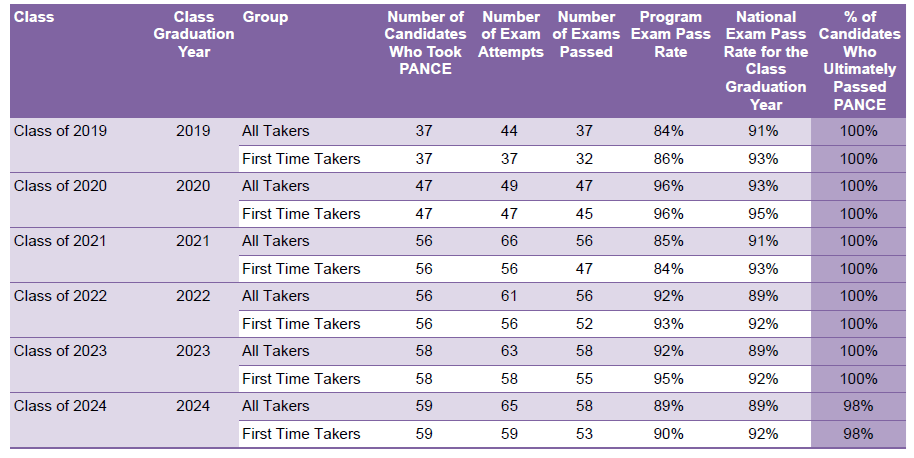Program Effectiveness In
Meeting Goals
Goal 1: Recruit and matriculate a student body that advances the mission of the program.
Rationale: We seek to prepare PAs to practice patient-centered healthcare in any clinical setting and to be responsive to community needs.
Outcome Measure: The FSU school of Physician Assistant Practice (SPAP) has set a benchmark that an aggregate minimum of 60% of each recruited and matriculated cohort is from a background with a Health Resources and Service Administration (HRSA) indicator. While the FSU SPAP engages in many recruitment activities which culminate with an invitation for interview, recruitment is defined for purposes of this goal as the number of applicants invited for an interview for determining goal achievement.
Timeline: This goal is evaluated annually in the spring of each year before April 1.
Actual Outcome: Goal achieved. The FSU School of Physician Assistant Practice has consistently recruited and matriculated a student body prepared to advance the mission of the program with at least 60% of our recruited and matriculated students have one or more HRSA indicators.
Goal 2: Graduate PAs that advance the mission of the FSU PA program by practicing in Primary Care specialties.
Rationale:Rationale: We seek to prepare PAs to provide patient centered healthcare to underserved populations, including elder, rural and underserved populations and in primary care settings.

Outcome Measure: The FSU SPAP has set a benchmark of 20% of each cohort who intend to care for underserved populations as reported on the program exit survey or alumni who practice in a primary care setting as self-reported for the alumni directory. Primary care specialties are defined as family medicine, internal medicine, pediatrics, obstetrics/gynecology and geriatrics.
Timeline: This goal is evaluated annually in the spring of each year before April 1.
Actual Outcome: Goal achieved. The 2024 exit survey revealed that 18% of the graduates from the 2024 graduating cohort plan to practice in a rural or underserved setting. Current alumni reported responses indicate that 22% of FSU PA alumni work in a primary care specialty.
Actual Outcome: Goal achieved. The 2024 exit survey revealed that 18% of the graduates from the 2024 graduating cohort plan to practice in a rural or underserved setting. Current alumni reported responses indicate that 22% of FSU PA alumni work in a primary care specialty.
Goal 3: Achieve first time PANCE pass rates at or above the national mean.
Rationale: We seek to prepare PAs to pass the Physician Assistant National Certifying Examination (PANCE).
Outcome Measure: The FSU SPAP has set a benchmark to achieve a first time PANCE pass rate that is at or above the national mean for first time PANCE pass rates.
Timeline: This goal is evaluated annually in the spring of each year before April 1.
Actual Outcome: Approaching goal. The FSU SPAP Class of 2024 First Time Takers PANCE pass rate is currently 89% with some graduates still to comple their first take of PANCE. The national PANCE pass rate for First Time Takers for the Class of 2024 is 92%.
Five-Year First Time Taker Summary Report

Goal 4: Graduate PAs that remain in Florida to practice as PAs.
Rationale: We seek to develop PAs who enter clinical practice and contribute to the needed healthcare workforce in the state of Florida.
Outcome Measure: The FSU SPAP has set a benchmark of 70% of graduates who practice in the state of Florida as determined by using FSU PA alumni National Provider Identifier (NPI) numbers.
Timeline: This goal is evaluated annually in the spring of each year before April 1.
Actual Outcome: Goal achieved. 77.1% of FSU PA alumni practice within the state of Florida according to NPI data.
| 2022 | 2023 | 2024 | Cumulative total alumni | |
| % of alumni who practice in Florida | 73.2% | 70.7% | 92.3% | 77.1% |
| % of alumni who practice outside of Florida | 26.8% | 29.3% | 7.7% | 22.9% |

